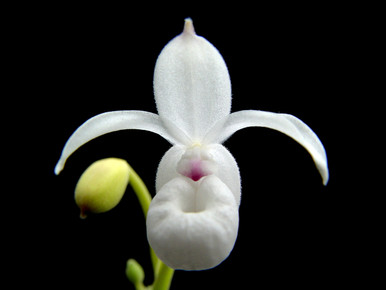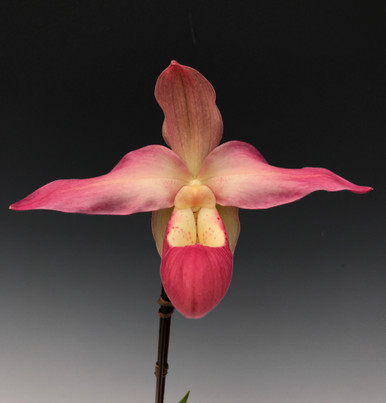Phragmipedium Orchid Care
Phragmipedium are new world ladyslippers that grow from Mexico down through the central and northern parts of South America. They can be found growing on rock outcroppings (Mexipedium xerophyticum), in forks of trees (Phrag. caudatum), or volcanic clay (Phrag. boisserianum, Phrag. wallisii). Some plants such as Phrag. longifolium, Phrag. ecuadorense, Phrag. pearcei, and Phrag. klotzscheanum grow submerged under water through periods of heavy rainfall.
The flowering season is heaviest in the spring. However many species can bloom for 6 to 11 months at a time, often one flower consecutively after another. The flower colors vary from green, to mahogany-pink, to the brightly fluorescent orange of Phrag. besseae discovered in 1981. Since then, Phragmipedium has been used to create several hybrids of amazing colors and shapes. Without a doubt, this genus of orchid produces some of the most eye popping flowers in the world!
Light and Shade
Most Phragmipedium do well in semi-shaded to bright light (2400 to 3000 foot-candles), similar to that of dappled sunlight. We recommend growing in east-facing windows, where the temperature is lower in the early part of the day when the plant is receiving the greatest amount of light. South-facing windows should only be used if shielded from the sun using a sheer curtain. Some species, including Phrag. besseae, Phrag. pearcei and Phrag. ecuadorense will do better in more shaded light (1000 to 1500 foot-candles), so that if a hand is passed over the leaves it does not produce a shadow. If using artificial light to grow indoors, LEDs are the best option for orchids. Phragmipedium prefer 11 hours of artificial light in winter, and 14 to 16 hours in summer. The artificial light market has expanded greatly in recent years, so a quick Google search will result in a variety of lighting options and price ranges. Phragmipedium will fail to flower if they are not receiving enough light to initiate blooming.
Temperature and Humidity
Phragmipedium generally do best in intermediate to warm conditions, preferring daytime temperatures of 70°F to 80°F (21°C to 27°C), and nighttime temperatures of 55°F to 65°F (13°C to 18°C). Some species will tolerate slightly warmer temperatures, including Phrag. longifolium, Phrag. sargentianum, Phrag. pearcei, Phrag. ecuadorense and Phrag. hirtzii. Phragmipedium will fail to flower if they do not experience a cool enough drop in temperature at night to initiate blooming. Phragmipedium thrive under high humidity and will benefit from humidity levels between 50% and 70%. This can be achieved at home with the use of a humidifier or a humidity tray. Just make sure that the plant is not standing in water or the roots will rot. Some Phragmipedium, like Phrag. caudatum, can take humidity down to 35% in nature during the dry season, but the roots are always moist and the nighttime humidity is high.
Watering
As semi-terrestrial orchids, Phragmipedium like to be kept fairly moist, with the media becoming only slightly damp between waterings. During warm dry weather, they may need to be watered 2 to 3 times a week. These orchids form wilted leaves, yellowed leaf tips, and rapid yellowing throughout the oldest base leaves, when not receiving enough water. If this happens, check the root system. Over-watering may have caused the roots to rot, thereby depriving the plant from absorbing water. If the roots are healthy, you are likely under-watering and should increase your watering schedule accordingly. Phrag. boisserianum and Phrag. besseae require clean water to do best. Water should be applied copiously as the plant approaches dryness. Do not let these plants become totally dry at the roots between watering! If in doubt: water. Plants which like somewhat drier conditions at the roots include Phrag. caudatum, Phrag. lindenii, Phrag. wallisii, and Mexipedium xerophyticum. We always recommend watering in the morning, as this gives the leaves time to dry and avoid bacterial growth overnight. If possible, use water low in alkalinity, such as rainwater, distilled water, or reverse osmosis water. If you have a dehumidifier in your home, the water that collects in the tray is excellent for watering orchids.
Feeding
We highly recommend Green Jungle Orchid Food, specially formulated to provide orchids with the nutrients they would naturally encounter in their wild habitats. This is the fertilizer that we developed to use on our own plants in production, with excellent results for decades! This formula works best with water low in alkalinity (such as rainwater, distilled water, or reverse osmosis water). However, you may use tap water, keeping in mind that mineral buildup will require repotting more frequently, on the order of every 1 to 2 years. If potting in bark mix, fertilize every time you water, flushing with non-softened water once a month. This rinses the media of salt and mineral buildup. When potting in rockwool mix, fertilize every 3rd watering year round.
Potting
Phragmipedium need to be potted in a medium that retains a lot of moisture. At Orchids Limited, we recommend potting these plants in our Modern Moisture Retentive Mix (contains rockwool). The Small or Medium grade of our Traditional Orchid Bark Mix can be used to pot the following species: Phrag. caudatum, Phrag. wallisii, Phrag. lindenii, Phrag. pearcei, Phrag. longifolium, Phrag. ecuadorense, Phrag. amazonicum, and Mexipedium xerophyticum.
Repot every 1 to 2 years, preferably in the spring or fall when temperatures are mild. Be careful to minimize disturbance to the root system, only removing dead or dying roots from the plant. Be careful to take off the old compost without causing damage to the live roots. Pot with oldest growth closest to the rim of the pot, allowing room for 1 to 2 years growth. We find that plastic pots work best for Phragmipedium. If the mix is old, crumbly and sour, carefully remove the media and rinse the root system. Trim off any dead roots and dead growths. Position the plant with its oldest growths to the edge of the new pot. Then, spreading the plant roots out, fill in the space with the potting medium. Should you wish to divide your plant at this time, each section should have 2 or three growths in addition to any new leads. Old leafless growths should be removed if the procedure will cause no damage to the rest of the plant. To avoid the transfer of orchid diseases, it is standard procedure to sterilize all cutting and potting instruments before using them on a plant. This can be done by flaming pruning shears with a butane torch, or by spraying with rubbing alcohol and wiping with a clean paper towel.
Pest Control
The main pest that Phragmipedium attract are mealybugs, which will hide in the leaf axis. The best treatment for mealybug is either a homemade pesticide of 1:1 parts water & rubbing alcohol, with a few drops of dish soap added. Spray the plants every few days, washing off the dead bugs in between. For large outbreaks, an application of a specially formulated pesticide spray every few days is more effective.
Featured Products
Shop all →





